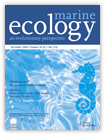Proximate Constituents, Biomass, and Energy in Posidonia oceanica (Potamogetonaceae)
Abstract
Abstract. The proximate composition of the various components of Posidonia oceanica is given in terms of gravimetric and energetic level and amount of plants from 2 depths at Port-Cros (Var. France). The level of proximate constituents differed little between the leaves (regardless of age) and the roots, but the rhizome contained much more soluble carbohydrate and less structural carbohydrate and ash. Because of this, the energy level in the leaves was more in terms of organic material and less in terms of total material than the energy level in the rhizome. The leaves of a P. oceanica shoot at 2 m depth in July contained 1.6 g organic material. 29.0 kJ. The weight and energy of the soluble carbohydrate in the rhizome from the base of the leaves to the 18th sheath scale decreased by ca. 40% from October to March and increased by ca. 100% from March to July.




